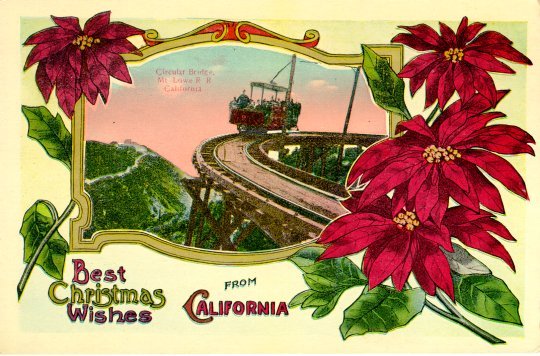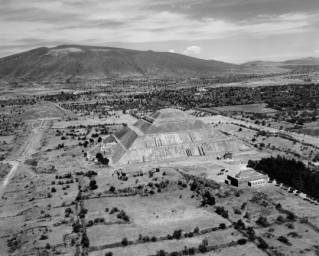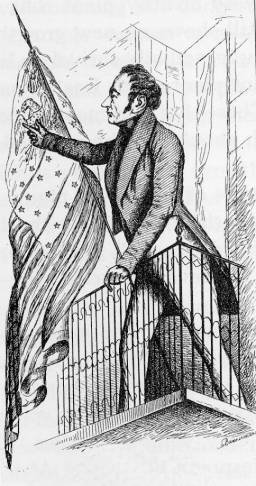
| Flora and Fauna |
What's the Poinsettia?
By Jake
Brouwer

What’s the point of the poinsettia you ask. Sure it’s a beautiful plant with its vibrant red bract leaves and yellow berries, but why do we have it abounding in our homes and offices at Christmas time? I thought most of our Christmas customs derived from Greek and Roman festivals, Norse pagan ceremonies and English Druid rites. In similar pattern most of the plants associated with Christmas like holly, mistletoe and evergreens are also from Europe and the Mediterranean. How did we come to take up the poinsettia as a Christmas plant and where did it come from?
First lets look at the variety of names attached to this plant. Officially it is Euphorbia Pulcherrima, a member of the spurge family, Euphorbiaceae. More commonly known as the poinsettia, this all but common plant has attracted such names as Christmas star, lobster plant, fire flower, flower of the holy night, painted leaf, Mexican flame leaf, and Cueslaxochiltl. Judging by the last names you may have guessed by now this plant has its origins in the New World. In fact we can trace it back to the pre-Hispanic times of the mighty Aztec Empire.
It is an ancient Aztec legend that says the first appearance of the plant came from an Aztec maiden who loved unwisely. The drops of blood from her broken heart showered upon the earth and everywhere the drops fell they took root and grew into the crimson plant.
 The Aztecs called the plant Cueslaxochiltl. Its name
represented purity and signified "flower that withers,
mortal flower that perishes like all that is pure." During
the times of this great empire beautiful botanical gardens were
grown. Flowers were cultivated for their beauty and their
medicinal purposes. The crimson Cueslaxochiltl was cultivated and
admired but rarely touched. It was an exotic gift of nature given
by the gods as a reminder of the periodic sacrifices given in
agreement with the creation of the Fifth Sun. The bright crimson
red of the leaves is said to represent Chalchimimatl, the
precious liquid of the sacrifices that was offered to the gods.
The Aztecs called the plant Cueslaxochiltl. Its name
represented purity and signified "flower that withers,
mortal flower that perishes like all that is pure." During
the times of this great empire beautiful botanical gardens were
grown. Flowers were cultivated for their beauty and their
medicinal purposes. The crimson Cueslaxochiltl was cultivated and
admired but rarely touched. It was an exotic gift of nature given
by the gods as a reminder of the periodic sacrifices given in
agreement with the creation of the Fifth Sun. The bright crimson
red of the leaves is said to represent Chalchimimatl, the
precious liquid of the sacrifices that was offered to the gods.
As we move through the centuries the plant takes a less ominous tone with the injection of Spanish influence into the culture. Originally symbolizing Aztec blood sacrifices it now becomes the symbol of the blood of Christ and represents Christmas.
A legend in 16th century Mexico says Franciscan friars evangelizing the area around Taxco celebrated one Christmas with a lavishly decorated nativity scene. Around the nativity luscious green plants were placed, Rosary’s and a litany were prayed, a piñata broken, gifts exchanged, and a mass was held. During the mass the plant decorating the nativity turned bright red. After that the flower was called Flor de Noche Buena or Flower of the Blessed or Holy Night.
Another early Mexican legend tells of a poor young girl on the way to church on Christmas Eve. She weeps because she has no gift to place on the altar of the virgin and child. Though her tears an angel appears and instructs her to gather plants from the dusty roadside. The other children mocked her gift but as she placed them on to the altar all were amazed as they transformed from the wilted greens to a starry crimson flower.
 In 1825 Dr. Joel
Roberts Poinsett served as the first U.S. Minister to Mexico.
Poinsett was also a botanist who traded seeds with friends around
the world. He first saw the wild plant growing along the dusty
Mexican roads. Later at the market he noticed customers buying
huge bunches of cuttings to decorate their homes and churches. He
learned that the plant’s leaves turned brilliant shades of
red in November and December in response to the longer nights.
When learning of the legends and customs surrounding the flaming
red plant he became determined to see it grown in his own
homeland. He shipped cuttings back home to his friends in
Greenville, South Carolina. The plants were well received. By
1829 Poinsett was asked to leave Mexico because of his brash
enthusiasm for Mexican politics. He had previously been recalled
from other South American posts because of indiscrete support of
local revolutionaries. Back home Poinsett began to propagate the
cuttings he brought back from Mexico in his greenhouses. He also
sent some to Philadelphia where they were grown in hot houses. At
first they were thought to be a new species of a new genus and
the plant was named after Dr. Joel Poinsett. So the poinsettia
had taken root in the United States.
In 1825 Dr. Joel
Roberts Poinsett served as the first U.S. Minister to Mexico.
Poinsett was also a botanist who traded seeds with friends around
the world. He first saw the wild plant growing along the dusty
Mexican roads. Later at the market he noticed customers buying
huge bunches of cuttings to decorate their homes and churches. He
learned that the plant’s leaves turned brilliant shades of
red in November and December in response to the longer nights.
When learning of the legends and customs surrounding the flaming
red plant he became determined to see it grown in his own
homeland. He shipped cuttings back home to his friends in
Greenville, South Carolina. The plants were well received. By
1829 Poinsett was asked to leave Mexico because of his brash
enthusiasm for Mexican politics. He had previously been recalled
from other South American posts because of indiscrete support of
local revolutionaries. Back home Poinsett began to propagate the
cuttings he brought back from Mexico in his greenhouses. He also
sent some to Philadelphia where they were grown in hot houses. At
first they were thought to be a new species of a new genus and
the plant was named after Dr. Joel Poinsett. So the poinsettia
had taken root in the United States.
Soon the poinsettia was being grown all over
the southern states particularly in Florida and California. The
poinsettia has become the Christmas plant in America. Today
florists sell them by the thousands to folks like you and me to
decorate our homes, offices, and bring us a little holiday
pleasure.
Send email to Echowebmaster@aaaim.com to report any problems.
Last modified: February 12, 1999
No part of this paper may be
reproduced in any form without written permission from:
Jake Brouwer
All articles and photos were provided by:
Land-Sea Discovery Group
Copyright © 1999